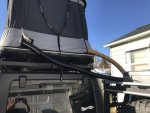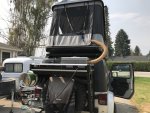Here we go . . . notes from a weekend field test! Some good news and some bad news, just like every field test . . .
Weather was 30F to 40F with constant precipitation (sleet, ice and rain). Wonderful weather for spending a weekend in a roof top tent, especially when packing up for off-road trail runs every day.
The good news:
1) Lining my tent with reflective emergency blankets worked great. It took less than five minutes to do it, and I think it dramatically changed the heat retention profile of the tent space (yes, I was careful NOT to cover the air vent soffits on either side). I'm thinking I should find a tailor shop that can cut and sew reflective blankets into roof top tent liners with Velcro attachment straps and sell them for profit!
2) I also tested a single UCO candle, which appeared to boost the air temperature in the tent as much as 10 degrees when combined with my own body heat. I have a 3-candle UCO lantern that I want to try next. I bet it helps dry out the air in wet conditions, too.
3) On the first night, the Propex system worked GREAT. It was 70F in my tent, and the heater cycled on/off several times during the night to refill my tent with warm, dry air. The insulated hoses I built worked perfectly.
The bad news:
1) The heater failed when I was getting dressed in the tent on the second morning. Thinking this was the "stuck valve" problem I had on my last field test, I shook the propane tank and banged it with the rubber mallet I packed for just this reason. Sure enough, the heater ignited perfectly on the next cycle. In case I needed to do the same trick again on the second night, I mounted the tank on a platform within reach of the tent window.
2) But during the second night, the heater would not light. I shook the propane tank, hoping to unstick the valve, but it didn't help. I decided not to bang it with the rubber mallet since there were others sleeping in tents around me. Fortunately, I had packed warm sleeping clothes and a 15F sleeping bag as my backup plan.
3) The next morning, there was PLENTY of tank banging and shaking, but still no luck getting the heater to light. And worse, when I got home and tried two other tanks . . . no lighting. I can see the hose pressurize and smell the puff of propane as it tries to light, so I am convinced there is a failure with the sparking mechanism. I am facing the chore of more hours invested in this heater project to troubleshoot this problem, which won't be easy. But then again, this crazy project was never about "easy" in the first place . . .



